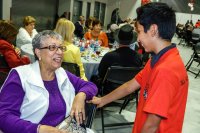Social and Emotional Learning in a World Language Class
Monthly visits to a nursing home taught middle school students empathy and built their confidence as they practiced their Spanish.
Your content has been saved!
Go to My Saved Content.As I began teaching my middle school Spanish students last year, I knew that in addition to guiding them through verb conjugations, I wanted to find a way to develop their social and emotional skills and offer them an opportunity to create positive change in our community. I got the inspiration for this when a couple of colleagues and I went to see Won’t You Be My Neighbor?, the documentary about Fred Rogers.
After a lot of reflection, I decided to introduce my students to neighbors in a nearby nursing home. In addition to giving students a context for practicing empathy, it would give them an audience for their fledging Spanish. Knowing that they would need to sing a song in Spanish for the nursing home residents, for example, could be a prod to practice more.
To begin, I used Google Maps to locate nursing homes within a five-mile radius of my school. I wanted to make sure the nursing home would be close enough to visit within a single class period, which was 60 minutes. I had to figure in travel time and make certain I was not interrupting other teachers’ instructional time.
I found a home called Morning Pointe and contacted their events coordinator to see if I could bring my students there for a visit once a month. When the coordinator agreed to this, I got started on logistics: preparing the permission slip, arranging the bus, emailing parents to inform them about this new partnership and to see if any of them wanted to chaperone a visit, and so on.
Field Trips for Social and Emotional Learning
Prior to our first visit to Morning Pointe, my students and I went over detailed expectations for how to behave, and I gave them some pointers, noting that they should talk slowly, project their voices, and engage the residents to the best of their abilities. This was very important because not all my students had a lot of exposure to or experience with the elderly.
I have 15 students, and there were about 10 to 15 residents in the dining area when we arrived. (The number of residents was roughly the same every time we visited, but they were not always the same people.) Some of my students felt very at ease right away about conversing with the residents, while others took some time to feel more comfortable. I assigned the students who felt reserved or nervous a peer buddy to walk around with—that gave them some help and support.
I also continued to engage with the residents myself to model how to interact with them, and made sure clusters of students weren’t hanging with each other rather than the residents.
I had had the students prepare two thank you notes in advance—something I did before each visit. One was for the bus driver and the other was for the residents. I felt it was important for my students to express gratitude. The thank you notes made the residents feel valued and helped break the ice between the students and residents.
Fostering a Sense of Purpose
To make the most out of these visits, I thought it would be best if they had a specific purpose. On the first visit, we helped serve lunch and dessert and introduced ourselves in Spanish. This helped students break the ice and allowed the residents to hear a little bit about each student. On the second visit, we sang a song in Spanish, which connected to our learning in a real world way. Students had to communicate to the residents what we were learning about.
For the third visit, we made cookies to share, and on the fourth, we played bingo—some students even called the numbers, which was fun to watch. For Valentine’s Day we made the residents cards and decorated cookies. Having themes and tasks for each visit was helpful for students as it gave them a purpose—they always felt like they knew what they were doing.
After each visit, I sent a follow-up email to the events coordinator thanking her for allowing us to visit. I also asked my students how they thought it went, how it made them feel, and what they learned from each visit. Their reflections revealed that they enjoyed the visits and wanted to continue them.
When I reflect on this special partnership between my students and the nursing home residents, I believe the visits helped my students blossom into kind and thoughtful teenagers. I witnessed my students feeling more and more comfortable and developing empathy for the elderly, regularly asking about them and showing more patience than usual when they were with them.
